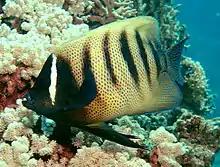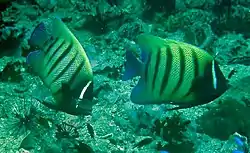Sixbar angelfish
The sixbar angelfish (Pomacanthus sexstriatus), also known as the six banded angelfish, is a marine angelfish belonging to the family Pomacanthidae.
| Sixbar angelfish | |
|---|---|
 | |
| Pomacanthus sexstriatus | |
| Scientific classification | |
| Kingdom: | Animalia |
| Phylum: | Chordata |
| Class: | Actinopterygii |
| Order: | Perciformes |
| Family: | Pomacanthidae |
| Genus: | Pomacanthus |
| Species: | P. sexstriatus |
| Binomial name | |
| Pomacanthus sexstriatus (Cuvier, 1831) | |
| Synonyms[1] | |
| |
Distribution
This species is native to the western Pacific Ocean. It is present in Australia, Cambodia, Indonesia, Japan, Malaysia, Micronesia, Myanmar, New Caledonia, Palau, Papua New Guinea, Philippines]], Singapore]], Solomon Islands]], Sri Lanka]], Taiwan]], Thailand, Vanuatu, Viet Nam.[2]
Habitat
This species commonly occurs in South Pacific reefs, most commonly in the Great Barrier Reef of Australia's north-east coast, at depths of 3 to 60 m. [3] It inhabits coastal, lagoon and outer reef slopes in clear water, with a preference for coral-rich areas. [2]
Description

Pomacanthus sexstriatus can reach a total body length of about 46 cm (18 in) in the ocean.[3] These angelfishes have 13-14 dorsal spines, 18-23 dorsal soft rays, 3 anal spines and 18-19 anal soft rays.[3] They have an easily recognisable very dark brown head. Body may have a yellow, silver white or cream coloration with black or brown vertical stripes (usually six on each side, hence the common name sixbar and the species name sexstriatus). There is one white vertical stripe on each side of its head. Fluorescent blue spots speckle the entire body, fins and tail. On the top and bottom fin and tail are present fluorescent blue lines.[4][5]
Like many juvenile angelfish, also the juveniles of this species have a pattern of white and light blue horizontal stripes on a dark blue background. The adult coloring is formed when they reach a length of 8–15 cm (3.1–5.9 in).
Biology and behavior
The six-banded angelfish is often seen in pairs, as it mates with one partner and they stay together for life. These tropical marine reef-associated fishes are omnivore, eating worms, mollusks, and tunicates, sponges, corals and algae, and they are also known to eat other fishes' eggs. Adults prefer areas with rich coral growth. The juveniles are particualrly common on shallow waters of reefs. [2][3][5]
In the aquarium
In captivity they may reach a maximum size around 30 cm. Despite being very sought after by many aquarists, the sixbar angelfish is very difficult to care for. [5]
References
| Wikispecies has information related to Sixbar angelfish. |
| Wikimedia Commons has media related to Pomacanthus sexstriatus. |
- WoRMS – World Register of Marine Species
- The IUCN Red List of Threatened Species 2010
- FishBase
- Randall, J.E., G.R. Allen and R.C. Steene, 1990. Fishes of the Great Barrier Reef and Coral Sea. University of Hawaii Press, Honolulu, Hawaii. 506 p.
- Central Pets
